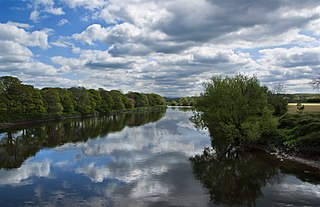
The River Ribble runs through North Yorkshire and Lancashire in Northern England. It starts close to the Ribblehead Viaduct in North Yorkshire, and is one of the few that start in the Yorkshire Dales and flow westwards towards the Irish Sea.

Penwortham is a town and civil parish in South Ribble, Lancashire, England, on the south bank of the River Ribble facing the city of Preston. The town is at the most westerly crossing point of the river, with major road and rail links crossing it here. The population of the town at the 2011 census was 23,047.
This is a list of Grade I listed buildings in Lancashire, England.
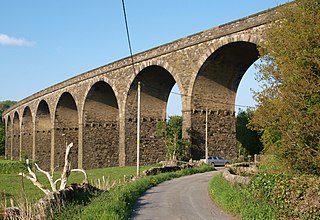
Martholme Viaduct is a 19th-century railway viaduct in the English county of Lancashire. It lies between the town of Great Harwood and the village of Read, and lies in both the district of Hyndburn and that of Ribble Valley. The viaduct was constructed 1870–77 by engineer Sturges Meek. It was built to carry the Great Harwood Loop of the East Lancashire Line over the River Calder. That part of the line closed in 1957.

St Wilfrid's Church is an Anglican church in Halton-on-Lune, a village in the English county of Lancashire. It is an active parish church in the Diocese of Blackburn and the archdeaconry of Lancaster. Halton may have been the site of an ancient Anglo-Saxon minster. Of the current structure, the tower dates from the 16th century and the remainder was built 1876–77 by Paley and Austin. The church is recorded in the National Heritage List for England as a designated Grade II listed building.

St Andrew's Church is in Blackpool Road, Ashton-on-Ribble, Preston, Lancashire, England. It is an active Anglican parish church in the deanery of Preston, the archdeaconry of Lancaster, and the diocese of Blackburn. The church is recorded in the National Heritage List for England as a designated Grade II listed building.

Skerton Bridge is a road bridge carrying the southbound lanes of the A6 road over the River Lune in Lancaster, Lancashire, England. The bridge is recorded in the National Heritage List for England as a designated Grade II* listed building and Scheduled Monument.
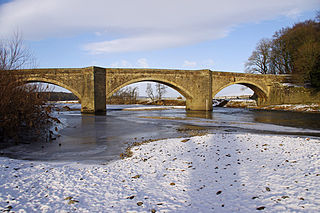
Loyn Bridge crosses the River Lune, carrying a minor road between the villages of Hornby and Gressingham in Lancashire, England. The present bridge replaces an older bridge, which is thought to have been constructed with timber decking between stone piers. There is evidence that the river was forded here before a bridge was built. The date of the building of the present bridge is unknown; it is considered to have been after 1591, when the previous bridge was described as being "in a dangerous condition". A date of 1684 has been suggested, but petitions regarding the bridge put before the Quarter Sessions between 1650 and 1750 make no mention of a new bridge between these dates. The bridge was paid for by the County of Lancashire, and later the responsibility for maintenance and repairs was transferred to the Lonsdale Hundred.
Dutton is a civil parish in Ribble Valley, Lancashire, England, located to the northeast of Ribchester. The parish is rural, with the River Ribble running to the south. It contains 15 buildings that are recorded in the National Heritage List for England as designated listed buildings. These mainly consist of houses with related structures, or farm buildings, but there are also a church, a bridge and two cross bases.
Preston is a city in Lancashire, England, that contains about 340 listed buildings. Its recorded history goes back to the Roman era, and in the medieval period it was a market town and a port, its first charter being granted in 1179. The city stands at the lowest crossing point of the River Ribble, which has given it great strategic importance. From the 16th century it was a centre for the spinning and weaving industries, and its greatest growth came from the 1770s with the development of steam power. By 1835 it contained 40 factories, and this had grown to 77 factories in 1869. Its population rose from about 12,000 in 1801 to about 69,000 in 1851, and one reflection of this was and this resulted in poor housing and social conditions. As a consequence of this there was fear of riots and other disturbances from the Chartists, the response to this being the building of Fulwood Barracks in the 1840s. There was much church building in the 19th century, including a number of notable Roman Catholic churches, reflecting the importance of Catholicism in the town and area. Later in the century and in the early 20th century the rise of civic pride and prosperity resulted in a number of notable civic buildings, particularly Fulwood Barracks. During the 20th century there was much clearing of slum properties, and of many other older buildings. The Preston Dock closed in the 1980s. Few of the 20th-century buildings have been listed, with the exception of the Central bus station and car park, which was opened in 1969 and had been threatened with demolition.
Barton is a civil parish in the City of Preston, Lancashire, England. It contains ten listed buildings that are recorded in the National Heritage List for England. Of these, one is at Grade II*, the middle grade, and the others are at Grade II, the lowest grade. The parish contains the village of Barton and surrounding countryside. Running through it is the Lancaster Canal, and a bridge crossing it and an aqueduct are listed. The other listed buildings include farm buildings, milestones, a church, and a cross.
Aighton, Bailey and Chaigley is a civil parish in Ribble Valley, Lancashire, England. It contains 55 listed buildings that are recorded in the National Heritage List for England. Of these, three are listed at Grade I, the highest of the three grades, five are at Grade II*, the middle grade, and the others are at Grade II, the lowest grade. The most important building in the parish is Stonyhurst College; many of the buildings comprising the college and associated with it are listed. The parish contains the village of Hurst Green, which also contains listed buildings, including houses, public houses, and almshouses. Outside these areas the listed buildings include other houses and associated structures, farmhouses and farm buildings, crosses, the ruins of a chapel, bridges, a mausoleum, a church, and a vicarage.
Clayton-le-Dale is a civil parish in Ribble Valley, Lancashire, England. It contains five listed buildings that are recorded in the National Heritage List for England. Of these, one is at Grade II*, the middle grade, and the others are at Grade II, the lowest grade. The parish contains the village of Clayton-le-Dale and surrounding countryside. The listed buildings consist of houses, a former toll house, and a bridge.
Great Mitton is a civil parish in Ribble Valley, Lancashire, England. It contains 17 listed buildings that are recorded in the National Heritage List for England. Of these, one is listed at Grade I, the highest of the three grades, one is at Grade II*, the middle grade, and the others are at Grade II, the lowest grade. The parish contains the village of Great Mitton and is otherwise completely rural. It is bounded by the Rivers Hodder and Ribble, and bridges crossing them are listed. The other listed buildings include houses, farmhouses, a barn, a church with associated strictures, public houses, a cross base, and a milestone.
Little Mitton is a civil parish in Ribble Valley, Lancashire, England. It contains two listed buildings that are recorded in the National Heritage List for England. Of these, one is at Grade II*, the middle grade, and the other is at Grade II, the lowest grade. The listed buildings are a former country house, later converted into a hotel, and a bridge crossing the River Ribble.
Penwortham is a civil parish in the South Ribble district of Lancashire, England. It contains 12 buildings that are recorded in the National Heritage List for England as designated listed buildings. Of these, one is listed at Grade II*, the middle grade, and the others are at Grade II, the lowest grade. The parish contains the town of Penwortham and surrounding countryside. The listed buildings include a medieval wayside cross, a church and structures in the churchyard, houses of varying dates, an inn, and a railway viaduct carrying the West Coast Main Line over the River Ribble.
Walton-le-Dale is a large village in the South Ribble district of Lancashire, England. In the area close to it are the settlements of Higher Walton, Walton Summit, Bamber Bridge, and Gregson Lane. This area contains 34 buildings that are recorded in the National Heritage List for England as designated listed buildings. Of these, six are listed at Grade II*, the middle grade, and the others are at Grade II, the lowest grade. The area is partly residential and partly rural. Its listed buildings include churches and associated structures, houses, farmhouses and farm buildings, public houses, and a war memorial.
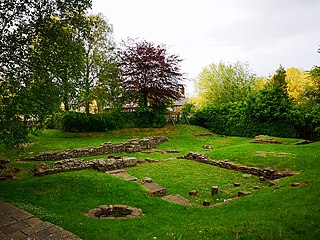
This is a list of scheduled monuments in the English county of Lancashire.

Ribchester Bridge is a toll-free, three-span bridge over the River Ribble near Ribchester, Lancashire, England. A Grade II listed structure, located about 0.75 miles (1.21 km) east of the village, it actually crosses the river between the civil parishes of Clayton-le-Dale and Dutton. The bridge carries the two-lane traffic of the B6245 Ribchester Road.
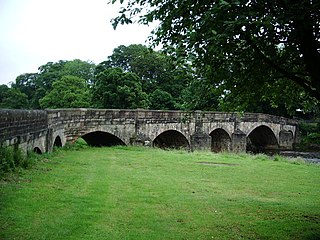
Edisford Bridge is a toll-free, nine-span bridge over the River Ribble near Clitheroe, Lancashire, England. A Grade II listed structure and a Scheduled monument, located about a mile WSW of the centre of town, it crosses the river to the civil parish of Great Mitton. The bridge carries the two-lane traffic of the B6243 Edisford Road.












